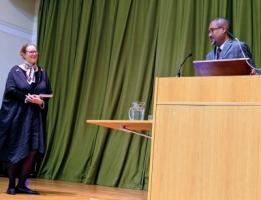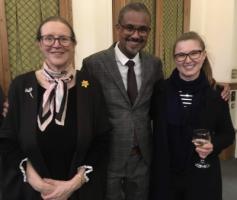
On the 21st of February, the Faculty hosted its annual Zaharoff lecture. This year, the address was given by esteemed writer and academic David Diop, whose literary success (I can vouch after having met him) is just as glowing as his humble and likeable personality. Introduced by his colleague and friend, Professor Catriona Seth, who happened to do her Doctorate with Diop at the Sorbonne, the author joined the ranks of previous recent Zaharoff speakers such as Scholastique Mukasonga, Chantal Thomas, Pierre Michon, and Marie Darrieussecq.
Born in France but raised in his father’s homeland of Senegal, Diop is the first French author and person of African descent to win the prestigious International Booker Prize, awarded in 2021 for his second novel Frère d’âme (translated by Anna Moschovakis as At Night All Blood is Black). He is not only a novelist but also a professor of 18th-century French and francophone literature at the University of Pau in southwestern France. Interestingly, Diop’s own name echoes that of Négritude poet David (Léon Mandessi) Diop, and perhaps this legacy runs in his veins.
Monsieur Diop’s talk was titled ‘Création littéraire et poétique de la voix’ (‘Literary Creation and Poetics of Voice’)1 and provided a fascinating insight into his writing process, particularly the literary influences, historical inspiration, and personal motivations for his novels. Above all, he insists, literary creation must begin with emotion. Borrowing from French philosopher Henri Bergson, via Senegalese poet and politician Léopold Sédar Senghor,2 he describes the undertaking as ‘supra-intellectual’ – that is, based on an intuitive rather than rational impulse. We can see this affective focus clearly in Frère d’âme (2018), which tells the story of two young Senegalese soldiers and childhood friends, Alfa Ndiaye and Mademba Diop, who are drafted to fight for France in World War I. With harrowing poignancy, the novel recounts Alfa’s descent into madness and brutality after Mademba is killed in battle.
Diop explains that he was inspired to write this story because his great-grandfather served in the war but refused to speak about his experiences. Some 200,000 tirailleurs sénégalais (‘Senegalese riflemen’, although this designation includes soldiers from West Africa more broadly) fought for France in the First World War, as Senegal had been under French imperial control since the mid-17th century (and did not gain independence until 1960). Although these soldiers – of which at least 30,000 died in the trenches – constituted a large part of France’s war effort, they are all but absent from French history books. Spurred by his great-grandfather’s silence, Diop began reading letters from French infantrymen and was again struck by the overwhelming lack of mention or perspective of the colonised soldiers.

Seeking to rectify this, Frère d’âme (which means ‘soul brother’ but is also a play on the term ‘frère d’armes’ – ‘brother in arms’) is Diop’s attempt at telling these occluded stories, imagining the personal experiences of the tirailleurs and bringing them to life through fiction. His choice to use first person, stream-of-consciousness style, or free indirect discourse, captures the intimacy of both the violence and friendship portrayed in the novel, enabling what Diop calls ‘un prolongement synesthétique de la mémoire’ – a synaesthetic continuation of memory that allows the experience of these soldiers to live on and inhabit all our senses rather than remaining mere statistics. The novel ultimately brings to the fore the barbarity and inhumanity of war precisely through its humanising, personal story. It seems Diop is playing here with the polyvalence of the term histoire in French, meaning at once ‘History’ (in the sense of official, state-sanctified versions of events) and ‘story’ (individual and affective narratives – fictional or otherwise).
This duality continues in the author’s latest novel, La Porte du voyage sans retour (2021) (Beyond the Door of No Return,translated by Sam Taylor in 2023), which narrativises, in epistolary form, the journey of real-life French naturalist Michel Adanson and his experience with the slave trade in 18th-century Senegal. Like Frère d’âme, it deploys interior monologues to construct a form of ‘psychorécit’, or psychological narrative, such as those used by Austrian playwright and author Arthur Schnitzler. Schnitzler, along with Ivorian novelist Ahmadou Kourouma3 and French writer Claire de Duras, had a profound influence on Diop, who often begins his characters’ musings with ellipses, as if the reader has interrupted a stream of thought. In the lecture, Diop tells us how he uses repetition to create rhythmic patterns in French that mimic the sonoric quality of Wolof, a West African language spoken widely in Senegal and which Diop himself spoke growing up. He owes this ‘stylistic debt’ to Kourouma, who, he explains, frequently employs repetition at the ends of phrases of dialogue to lend a certain ‘otherness’ to his characters’ speech. Similarly, Diop aims to ‘make the voice of the subaltern heard’ by adding ‘colour’ to Alfa’s narration in Frère d’âme. Since the protagonist does not speak French yet the novel is written in French, Diop mobilises the musicality of Wolof to indicate that Alfa thinks – and lives – in another language.
For the author, inhabiting another language is more than a lexical pursuit; it is about translating a culture, a worldview, and lived experience, since the way we express ourselves is necessarily imbricated in our sense of identity and belonging. By mapping the syntax and intonations of Wolof onto the protagonist’s French, Diop manages to ‘let the language “behind” be heard’ – the hidden tongue; la langue autre. These palimpsestic layers not only capture the orality that is so central to African storytelling but also transmit an element of spirituality through the mystical and ‘foreign’ quality of the French prose. The rich complexity of these inner monologues exposes the absurdity of the belittling ‘petit nègre’, or pidgin French, that was taught to colonised troops so they could understand orders (and subsequently used to mock them). Like the characters in Claire de Duras’s Ourika, which partly inspired the voice of the protagonist in La Porte du voyage sans retour, Diop’s own characters are both the recipients and the transcribers of their stories – as the author puts it, they are the ‘transmitters of African thought’. He laments, however, that there is a sad irony to la voix interne (one’s inner voice), for although it provides insight and individuality, ‘it can shout and shout but, in the end, it still remains inaudible’.
Nonetheless, this does not diminish the sense of emotional ‘urgence’ that the author feels towards the creative process. When asked about his approach to academic writing and whether a similar affective ‘urgency’ applies, Diop replies that he thinks through academic writing but that one must feel one’s way through fiction. While this neatly (and poetically) encapsulates the difference between the two disciplines, it might lead one to wonder whether for Diop, who so seamlessly blends his creative writing with historical narrative based on archival research, these processes can be so easily disentangled, or if they necessarily bleed into each other to create a mutual voix créatrice.
1 All translations from the event are my own.
2 Senghor was one of the founders of the anticolonial Négritude movement – a pan-African affirmation and celebration of Black culture and identity. In addition to being a poet and cultural theorist, he was also the first president of free Senegal (1960-80).
3 Fittingly, Diop won the Prix Ahmadou Kourouma for Frère d’âme in 2019 (along with multiple other awards, including the Prix Goncourt des Lycéens in 2018 and the International Booker Prize for the English translation in 2021, noted above). It is now being translated into thirteen other languages.